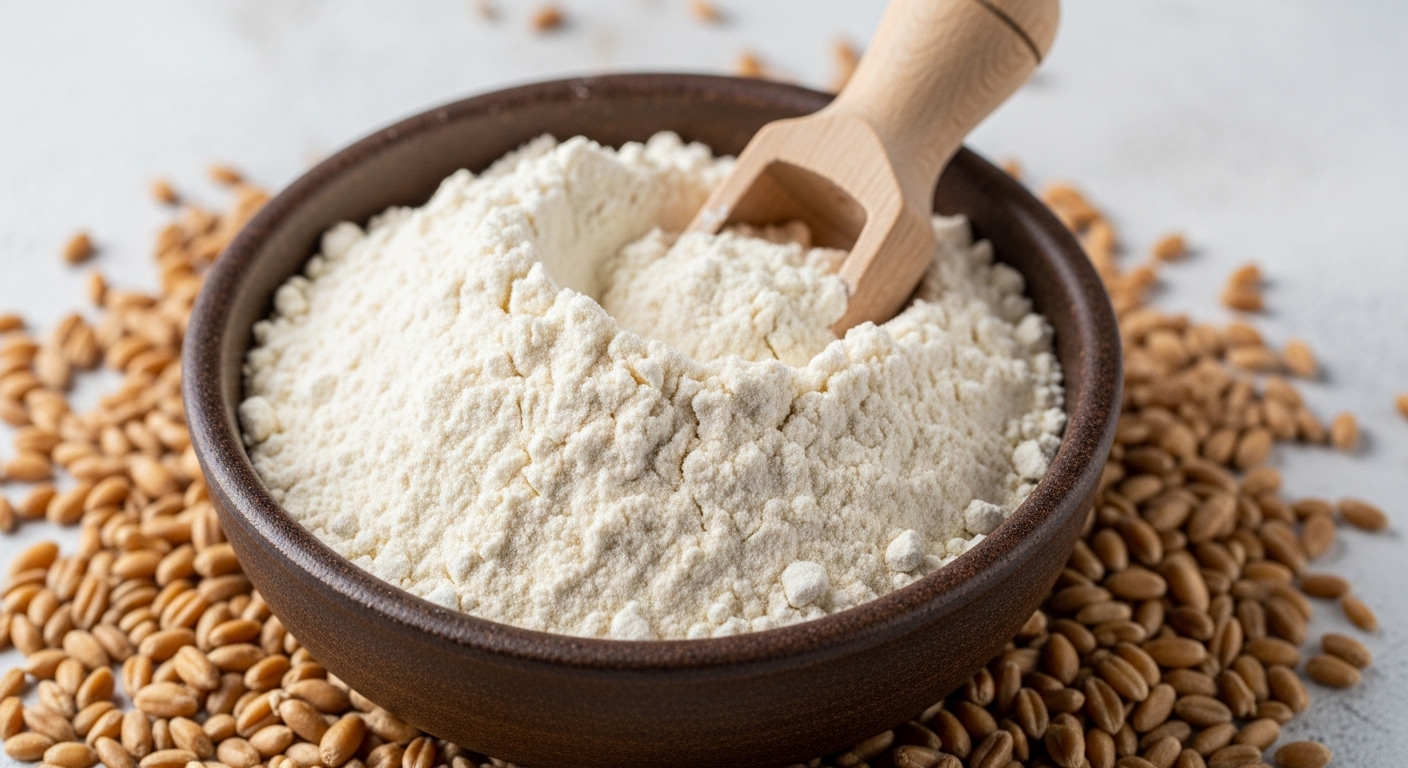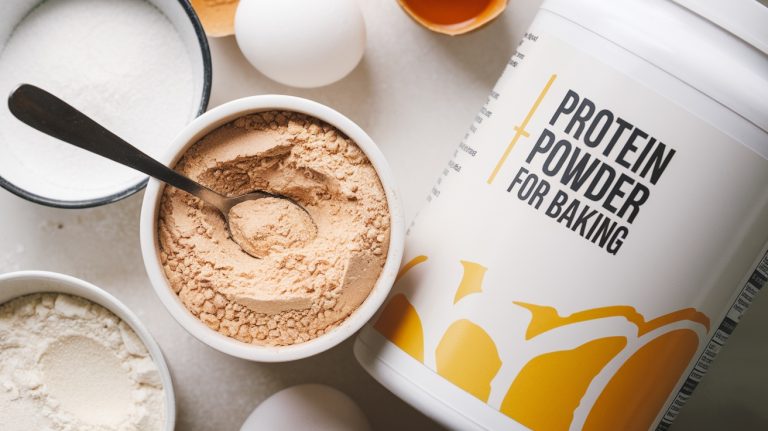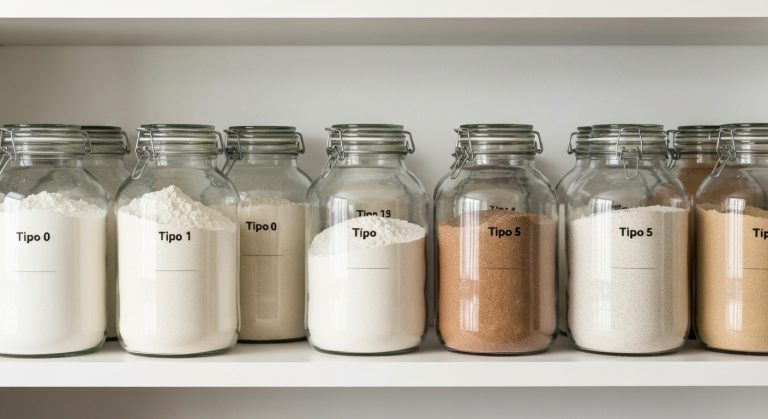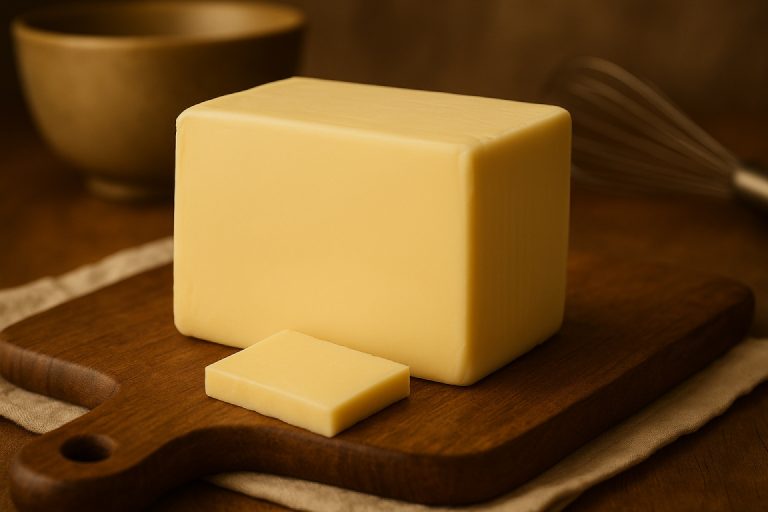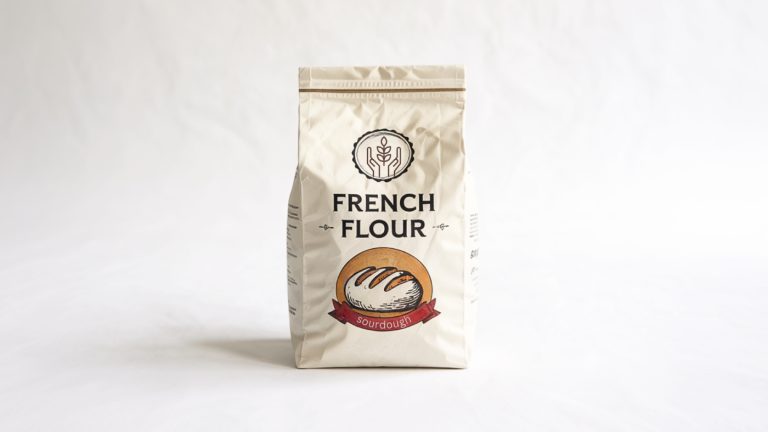What Is Unbromated Flour and Why Bakers Prefer It?
You’re choosing unbromated flour when you want chemically untreated wheat flour that relies on natural oxidation to strengthen gluten over time. It’s typically unbleached and retains essential nutrients like B vitamins, iron, and fiber by preserving the whole wheat kernel.
Unlike bromated flour, it avoids carcinogenic risks associated with potassium bromate and supports healthier baking. Its moderate elasticity and natural aging improve dough quality without additives.
Understanding its production, benefits, and uses can reveal why it’s favored in clean-label baking.
Key Takeaways
- Unbromated flour is wheat flour processed without potassium bromate, relying on natural aging to develop gluten strength and whiteness.
- It retains more nutrients like B vitamins, iron, magnesium, phosphorus, and higher dietary fiber than bromated or refined flour.
- The flour has a natural creamy color and firm, dense crumb due to absence of chemical bleaching or strengthening agents.
- Unbromated flour supports moderate gluten elasticity, moisture retention, and produces reliably textured bread and baked goods.
- It is considered safer and healthier, as potassium bromate is linked to carcinogenic risks and banned in many countries.
Definition and Composition of Unbromated Flour
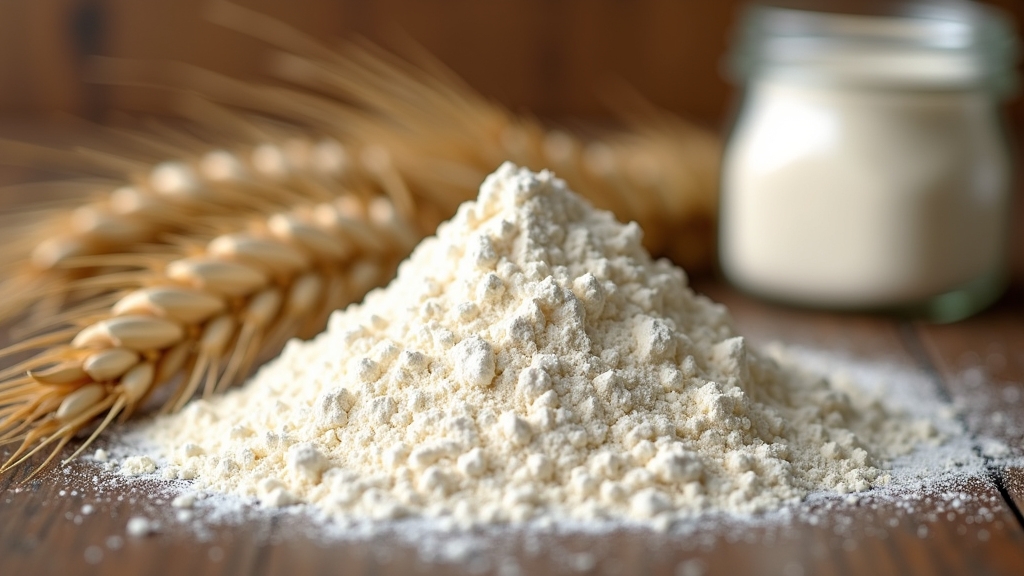
Although unbromated flour excludes potassium bromate, a chemical once added to strengthen dough, it retains the wheat’s natural gluten and color characteristics.
Unbromated flour skips potassium bromate, preserving the wheat’s natural gluten and color qualities.
This flour is produced without bromate or similar oxidizing agents, relying instead on natural oxidation during milling and aging. You’ll find that unbromated flour preserves the wheat’s native gluten structure, resulting in slower, more natural gluten development. Using the correct measurement precision when weighing flour is essential to achieve consistent dough quality with unbromated flour.
It’s typically unbleached, maintaining the wheat’s cream or off-white color without artificial whitening. Often, this means it has a slightly off-white or creamy color compared to bleached varieties.
Its composition reflects a straightforward milling process without chemical accelerants, which means dough strength and elasticity develop naturally.
When you use unbromated flour, you’re working with a product free from bromate-related additives, favoring a more natural, additive-free baking ingredient that maintains the original wheat qualities and requires adjusted handling for ideal results.
Historical Use of Potassium Bromate in Flour
When potassium bromate was patented in the early 20th century, it quickly became a favored additive in bread baking for its ability to accelerate gluten development and improve dough strength.
You’ll find it replaced slower natural aging processes, producing bread that’s whiter, softer, and fluffier.
It gained widespread commercial use by mid-century due to its efficiency and consistency, especially in industrial baking environments that valued rapid dough preparation.
Key historical points include:
- Patented around 1914-1915 as a chemical oxidizing agent to enhance dough properties.
- Replaced iodate and natural aging, boosting industrial bakery productivity.
- Widely adopted in the US before stringent food additive regulations began in 1958.
- Its use spread globally but later faced bans due to health concerns.
Despite its benefits in baking, health risks associated with potassium bromate, such as its carcinogenic potential, eventually led to regulatory actions and bans in many countries.
This history sets the stage for understanding why unbromated flour emerged.
Health Implications of Bromated Versus Unbromated Flour
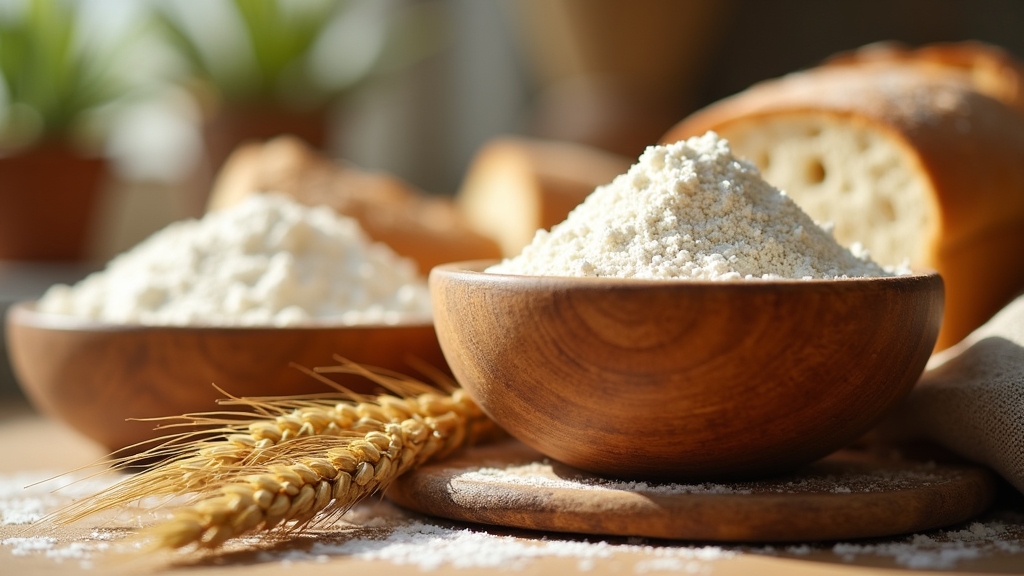
How does the presence of potassium bromate in flour impact your health compared to unbromated alternatives?
Potassium bromate poses significant carcinogenic risks, linked to kidney, thyroid, and mesothelioma cancers, primarily due to its mutagenic and cytotoxic effects causing oxidative DNA damage.
Prolonged consumption of bromated flour increases cancer probabilities substantially.
Acute exposure can cause respiratory and gastrointestinal symptoms, while chronic intake risks organ damage. However, when used correctly within regulated limits, potassium bromate residues in baked goods are minimal and generally considered safe.
Although regulatory agencies like the FDA permit limited bromate residues, incomplete conversion during baking may leave harmful levels in bread.
In contrast, unbromated flour eliminates these chemical hazards, preventing oxidative stress and cellular damage.
Production Methods for Unbromated Flour
Because unbromated flour excludes chemical oxidizers like potassium bromate, its production relies on carefully controlled milling and natural processes to develop ideal baking characteristics.
Unbromated flour is crafted through precise milling and natural aging to achieve perfect baking qualities without chemical oxidizers.
You’ll find that the process emphasizes preserving wheat integrity and enhancing dough functionality through natural means.
Key production steps include:
- Milling wheat using stone or steel grinders to retain nutrients and flavor without bromate treatment.
- Naturally aging flour for weeks to months, allowing oxygen exposure to improve protein quality and dough strength. This natural aging process also retains more nutrients compared to bleached or bromated flours.
- Incorporating safe dough conditioners like ascorbic acid or enzymes to mimic bromate’s strengthening effects.
- Conducting rigorous quality control, including moisture and protein testing, to ensure consistent performance and safety. This natural approach aligns with methods that help maintain dough hydration and texture in baking.
This approach prioritizes natural maturation and precise milling to achieve high-quality unbromated flour.
Differences in Baking Performance and Texture
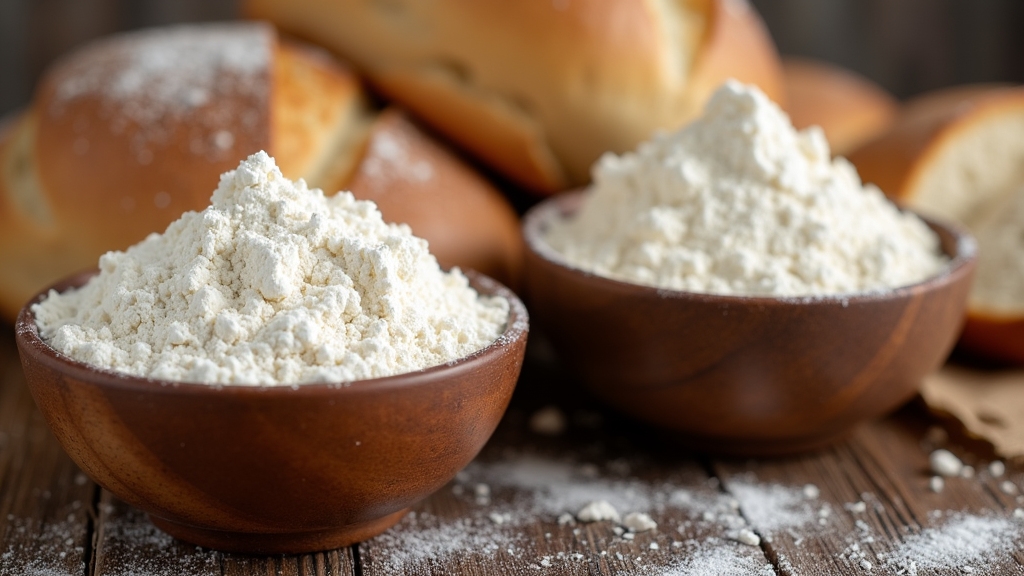
When you work with unbromated flour, you’ll notice the dough exhibits less elasticity but greater extensibility. This affects how it handles during mixing and shaping.
Unbromated flour may produce a slightly weaker dough, potentially requiring adjustments in mixing time or water content to compensate for its dough strength. This difference influences the crumb structure, often resulting in a softer, more open texture compared to bromated flour.
Understanding these variations helps you adjust your technique to achieve the desired baking performance. Using the right mixing bowl size can also aid in managing dough consistency and expansion. By adapting your methods, you can ensure the final product meets your quality expectations. Paying attention to these characteristics will improve your overall baking results.
Dough Elasticity Variations
Although unbromated flour lacks chemical enhancers like potassium bromate, you’ll notice that variations in dough elasticity considerably impact baking performance and final texture.
Without bromate, dough strength depends on natural gluten quality, affecting gas retention and loaf volume. You must balance elasticity to avoid overly dense or collapsed loaves. Proper fermentation also plays a role in improving dough properties and nutrient absorption through bioavailability.
Consider these factors:
- High elasticity yields chewier, denser bread with smaller air pockets due to resistance to expansion.
- Low elasticity causes weak gluten networks, leading to flat, irregular, or fragile crumb structures.
- Balanced elasticity promotes even gas distribution, consistent rise, and improved shelf life. During fermentation, gluten softens, which naturally decreases elasticity and increases extensibility, aiding dough expansion. This gluten relaxation process is crucial for managing dough properties.
- Handling dough becomes more challenging as elasticity increases, affecting shaping and final loaf form.
Selecting high-protein unbromated flour helps maintain acceptable elasticity for reliable baking outcomes.
Crumb Structure Differences
Understanding dough elasticity sets the stage for examining how unbromated flour influences crumb structure and texture.
When you bake with unbromated flour, expect a firmer, denser crumb with a uniform, fine network of starch and gluten. This flour’s natural aging process strengthens gluten gradually, avoiding the overly strong doughs bromated flour can produce, which often create irregular, large holes.
Because unbromated flour is unbleached and naturally aged, it retains more of the wheat’s natural nutrients and a creamier color. It is often preferred in recipes that benefit from improved gluten development and balanced dough consistency.
You’ll notice a medium to fine crumb texture with moderate springiness, balancing chewiness and softness without becoming gummy.
The gluten matrix improves moisture retention, contributing to a moist crumb that stays fresher longer.
Additionally, the crumb color tends to be creamier and more consistent, reflecting natural oxidation rather than chemical bleaching.
Nutritional Benefits of Choosing Unbromated Flour
Because unbromated flour undergoes minimal processing, it retains essential nutrients such as B vitamins, iron, magnesium, and phosphorus. These nutrients support energy metabolism, bone health, and immune function.
This type of flour is often made by grinding the entire wheat kernel, including the bran, germ, and endosperm, which helps preserve its natural nutrient content whole wheat kernel. Choosing the right measuring tools, such as those with measurement accuracy, can help ensure precise ingredient proportions when baking with unbromated flour.
Choosing unbromated flour benefits you by preserving natural vitamins and minerals critical for metabolic and immune functions.
Opt for unbromated flour to retain essential vitamins and minerals vital for metabolism and immunity.
It also offers higher protein and antioxidant levels, which aid cellular health and help reduce oxidative stress.
Additionally, unbromated flour provides increased dietary fiber—up to three times that of refined flour—promoting digestive regulation and glycemic control.
Importantly, it eliminates exposure to potassium bromate and bleaching agents, reducing potential carcinogenic and inflammatory risks.
These nutritional advantages mean you get a nutrient-dense flour that supports better health outcomes while maintaining baking quality without chemical additives.
Natural Aging Versus Chemical Processing Techniques
Preserving the nutritional integrity of unbromated flour relies not only on ingredient selection but also on how the flour is processed after milling.
Natural aging takes about 1–2 months. This process allows oxidation to whiten the flour and strengthen gluten without the use of chemicals. During this time, the flour’s color changes from yellowish to white, improving its baking qualities through natural aging. This slow process also supports the development of gluten strength essential for artisanal bread baking.
Chemical bleaching, on the other hand, uses agents like benzoyl peroxide to whiten flour rapidly. However, it can weaken gluten and alter the texture of the flour.
Potassium bromate, often avoided in unbromated flour, enhances dough strength. Despite this benefit, it raises health concerns.
| Process | Duration | Effects on Flour |
|---|---|---|
| Natural Aging | 1–2 months | Whitens, strengthens gluten |
| Chemical Bleaching | Hours to days | Rapid whitening, weak gluten |
| Potassium Bromate | Minutes to hours | Stronger dough, health risk |
Choosing natural aging preserves flour’s natural qualities but requires patience and storage.
Consumer Trends and Market Availability
You’re seeing a clear rise in consumer demand for unbromated flour, driven by health-conscious buyers seeking natural and minimally processed ingredients. Many consumers also pay attention to food safety and ingredient transparency when choosing products.
Retailers are expanding availability through specialty stores and e-commerce, improving access to these niche products.
Transparent labeling now plays a vital role, helping you identify unbromated flour amid growing interest in clean-label and organic options. This trend aligns with the overall market growth, as the unbleached flour sector is projected to reach USD 13.5 billion by 2033, growing at a CAGR of 4.8%.
Rising Consumer Demand
How are shifting consumer preferences reshaping the demand for unbromated flour? You’ll find that growing awareness of clean-label, chemical-free foods drives demand for unbromated flour, perceived as healthier due to the absence of bromating agents.
The rise in home baking post-pandemic also fuels interest, as you seek authentic textures and traditional baking outcomes. Additionally, technological advancements in packaging have improved the shelf life and quality of unbromated flour, making it more accessible to consumers.
Moreover, the choice of flour type significantly impacts baking results, as seen in white flour sourdough which offers a soft loaf with subtle tang. However, pricing remains a key factor limiting accessibility for budget-conscious consumers.
Consider these key drivers:
- Preference for minimally processed, nutrient-preserving ingredients.
- Increased home baking with emphasis on traditional methods and textures.
- Clean-label demand aligning with health and organic market growth.
- Price sensitivity causing market segmentation, favoring developed regions with higher disposable incomes.
Understanding these dynamics helps you appreciate the nuanced consumer-driven growth of unbromated flour.
Retail Availability Expansion
As consumer interest in unbromated flour grows, retailers have expanded availability across diverse channels to meet varied purchasing preferences. Major supermarkets and hypermarkets stock unbleached flour extensively, offering wide selections for convenience.
This expansion is particularly strong in the Asia Pacific region, where rising middle-class populations and increasing disposable incomes drive demand for such products, supporting the regional dominance.
Convenience stores provide smaller packaging for quick, low-quantity purchases. Online platforms rapidly increase offerings, enabling home delivery and price comparisons.
Specialty stores focus on premium, organic variants, targeting health-conscious buyers. Geographic expansion centers on North America and Europe, with emerging urban markets showing rising demand due to health awareness.
Private label products gain traction in supermarkets, offering competitive pricing and fueling distribution growth. Packaging innovations range from bulk formats to ready-to-use mixes, emphasizing chemical-free processing.
This multi-channel, diversified retail expansion ensures unbromated flour is accessible to both casual consumers and institutional buyers across evolving market landscapes.
Labeling and Transparency
Although labeling regulations set strict requirements for flour products, consumer demand for transparency has driven manufacturers to provide clearer information about ingredient sourcing and processing.
You’ll notice labels now often specify whether flour is unbromated or unbleached, reflecting precise compliance with federal acts like the FD&C Act. Additionally, net quantity must be declared properly by weight in metric units to ensure clear communication to consumers.
This clarity helps you make informed choices and supports food safety standards.
Key aspects to consider include:
- Mandatory allergen disclosures and ingredient accuracy per FDA and Canadian regulations.
- Temporary FDA flexibility allowing unbleached flour substitution without label changes during supply disruptions.
- Voluntary “unbromated” claims serving as marketing points aligned with clean-label trends.
- Industry adaptations balancing regulatory compliance with consumer demand for transparent, trustworthy labeling.
This evolving landscape ensures you get precise, reliable product information.
Regulatory Status of Potassium Bromate Worldwide
Because potassium bromate poses significant health risks, many countries have enacted strict regulations or outright bans on its use as a flour additive. Europe, Canada, India, Nigeria, Brazil, Argentina, South Korea, Peru, China, and Sri Lanka prohibit potassium bromate due to its carcinogenic potential.
In the U.S., the FDA classifies it as Generally Recognized As Safe (GRAS) under 21 CFR Part 172.730, allowing limited residual levels (0.0075 parts per 100 parts flour). However, states like California enforce bans reflecting heightened caution.
Notably, California’s Food Safety Act will prohibit potassium bromate starting in 2027, making it the first state to ban an additive deemed safe by the FDA, aiming to enhance food safety and reduce health risks related to additive residues.
Internationally, permissible concentrations vary widely—Japan permits up to 10 mg/kg, China up to 50 mg/kg, while banned countries allow none.
The absence of universal guidelines contrasts with FAO/WHO recommendations advocating global bans.
These regulatory differences highlight ongoing risk management challenges relating to potassium bromate in flour treatment.
Common Uses and Recipes Featuring Unbromated Flour
Concerns over potassium bromate have led many bakers to choose unbromated flour for their recipes. This flour supports natural gluten development, ideal for yeast breads like sourdough. It produces chewy crumbs and well-colored crusts without chemical bleaching.
Unbromated flour is also favored in pastry making. It provides sturdier shells and an authentic wheat flavor, enhancing the overall quality of pastries. Because it is not chemically treated, unbromated flour undergoes natural aging which affects the texture of the final product.
In home baking, you can substitute it easily in cookies, cakes, and pizza dough. Using unbromated flour can enhance texture and wholesomeness in these everyday treats.
Additionally, unbromated flour retains more nutrients. This makes it suitable for whole grain and health-focused recipes, adding nutritional value.
Common uses include:
- Artisan breads requiring elasticity and extended fermentation
- Pastries demanding precise dough structure
- Everyday baked goods promoting additive-free nutrition
- Whole grain recipes emphasizing natural flavor and fiber
Using unbromated flour guarantees chemical-free, quality baking outcomes.
Frequently Asked Questions
How Should Unbromated Flour Be Stored for Best Freshness?
Think of unbromated flour like a delicate artifact—you need to preserve it carefully. Store it in an airtight container, ideally with oxygen absorbers, to prevent oxidation and pests.
Keep it in a cool, dark place; refrigeration or freezing extends freshness beyond a year.
Avoid heat and moisture to prevent spoilage.
Label your containers with dates for proper rotation, ensuring you use your flour while it’s still at its peak quality and flavor.
Can Unbromated Flour Be Used for Gluten-Free Baking?
You shouldn’t use unbromated flour for gluten-free baking because it contains inherent gluten from wheat. It doesn’t meet gluten-free requirements and can cause adverse reactions in those with gluten intolerance or celiac disease.
Instead, opt for certified gluten-free flours like rice, almond, or coconut flour. These alternatives, combined with binders like xanthan gum, replicate gluten’s structure, ensuring safety and desired texture in gluten-free recipes.
Does Unbromated Flour Have a Shorter Shelf Life Than Bromated Flour?
Think of bromated flour as a well-armored knight, while unbromated flour is a nimble scout.
You’ll find unbromated flour doesn’t necessarily spoil faster, but it lacks bromate’s chemical aging, so it can be more sensitive to environment.
Proper storage is your key—airtight, cool, dry conditions keep it fresh.
What Is the Price Difference Between Unbromated and Bromated Flour?
You’ll typically find unbromated flour priced about 10-30% higher than bromated flour due to its premium, natural positioning and often smaller-scale production.
Bromated flour tends to be cheaper, benefiting from chemical additives that speed processing and bulk production efficiencies.
Regional regulations and consumer demand for additive-free products further influence pricing, so expect unbromated flour costs to vary with brand, certification, and market availability.
Are There Specific Brands Known for High-Quality Unbromated Flour?
Yes, you’ll find King Arthur Flour, Bob’s Red Mill, Central Milling, and Hodgson Mill among the top brands known for high-quality unbromated flour. They emphasize natural, unbleached, additive-free products with consistent performance.
For organic options, Arrowhead Mills stands out. These brands cater to both professional and home bakers seeking authentic flavor and texture, often available through specialty retailers or health food stores.
Bake Better, Live Better: Go Unbromated
When you choose unbromated flour, you’re opting for a product crafted without potassium bromate, relying on natural aging or alternative methods.
Picture dough rising gently, free from chemical acceleration, yielding a texture that’s wholesome and reliable.
Understanding these subtle differences helps you bake with confidence, knowing your flour supports both health and traditional quality.
As consumer demand shifts, unbromated flour stands out as a safer, more transparent choice in your kitchen.

